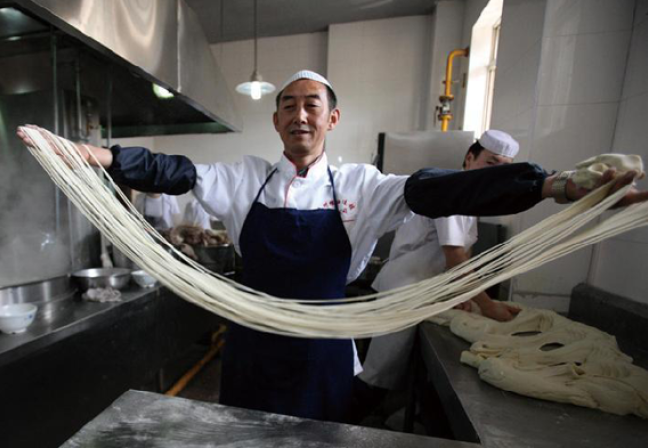This unique and entertaining method of making noodles by hand originated in China. The earliest written record of Chinese noodle culture is dated to the Eastern Han period (25–220 CE). The earliest description of the method to make lamian (pulled noodle) is dated to 1504. Today, the popularity of this soft wheat noodle has spread far and wide. See how Chinese hand-pulled noodles are made like The Blake School students did when visiting Shiquan!
There are many stories about the origin of noodles. In the early 2000s, a 4,000 year old bowl of noodles was found at an archaeological site in northern China. The bowl was overturned, and perfectly intact long yellow strands of millet noodles were found inside. Before this discovery, the earliest mention of noodles was in a book written in the Han Dynasty about 2000 years ago. We do not have written records from other cultures mentioning noodles that date back as far as 4,000 years, so we can safely assume at this time they were originated in China.
In China, noodles can be thick and round, thick and flat, skinny straight, or skinny wavy. An early form of noodles were small bits of bread dough tossed into boiling water called mian pian (square flat noodles), dao shao noodles (thicker noodles hand-cut with a knife), and mao er duo (“cat’s ear” noodles similar to orecchiette). Hand-pulled noodles (la mian) featured in the video above, is an art form that requires long hours of practice, and an even longer time to master. Once formed, noodles can be stir-fried, steamed, boiled, pan-fried, deep-fried, or simmered in soup. There are thousands of varieties of noodles in China, according to the classification of the shape of noodles, sauces, local characteristics and the way they are prepared.
When eating noodles, the foremost concern is flavor and texture. Wheat noodles are best when they are springy. Rice noodles should be smooth, not too firm and not too soft. The sauce or soup that accompanies them should compliment and elevate the flavor of the noodle dish. Did you know that slurping while eating noodles is allowed? It is highly encouraged because it means you are really enjoying the noodles you’re eating.
Let us assist in planning your next immersion experience and help make it accessible to all of your students! We have many destination options for Language Immersion programs worldwide. Necessary traveler protections for teachers and students are already integrated into our programs too! Contact us today!

